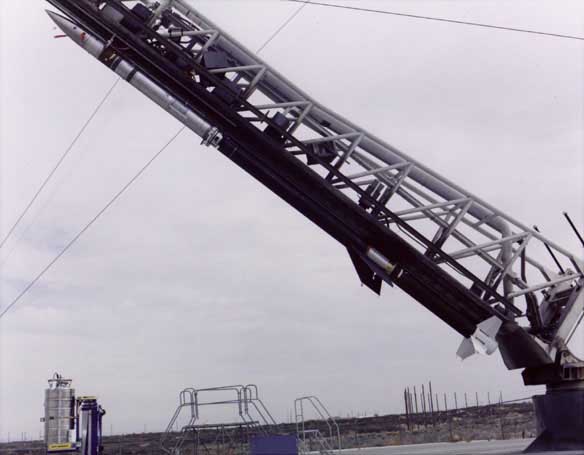Introduction
 Welcome to the XQC sounding rocket experiment. XQC stands for X-Ray Quantum Calorimeter, a soft x-ray spectrometer used for suborbital astrophysical observations. The XQC sounding rocket payload is designed to study the diffuse X-Ray background in the energy range from 0.05 to 1 keV at very high spectral resolution. The diffuse x-ray background is thought to emanate from a local region of hot interstellar gas. Previous experiments have implied that this gas is a hot, low density plasma but did not have the resolving power to distinguish individual emission lines over a broad spectral range. This experiment is able to resolve line emission from the hot plasma.
Welcome to the XQC sounding rocket experiment. XQC stands for X-Ray Quantum Calorimeter, a soft x-ray spectrometer used for suborbital astrophysical observations. The XQC sounding rocket payload is designed to study the diffuse X-Ray background in the energy range from 0.05 to 1 keV at very high spectral resolution. The diffuse x-ray background is thought to emanate from a local region of hot interstellar gas. Previous experiments have implied that this gas is a hot, low density plasma but did not have the resolving power to distinguish individual emission lines over a broad spectral range. This experiment is able to resolve line emission from the hot plasma.
The launch vehicle for the XQC detector is a Nike-Black Brant two stage sounding rocket. The rocket was assembled at White Sands Missile Range by NASA's Wallops Flight Facility. Sounding rocket flights are quite short in duration, approximately 15 minutes, but obtain an altitude above 220 km. The XQC experiment was designed to have an observing time of only 240 seconds during the flight, sufficient, however, to obtain a reasonable spectroscopic observation.
 The XQC experiment has been launched three times from White Sands Missile Range in New Mexico; twice successfully. Successful observations were made on June 3, 1996 and March 28, 1999. Both times, the experiment observed a large portion of the northern sky for 240 seconds before landing via parachute about 80 miles up-range in the New Mexico desert. Preliminary results from these flights show emission lines from several highly ionized atoms in both the Wisconsin C and M spectral bands. Analysis of the flight data and calibrations of the flight detector and filters continue to be performed by the experiment team.
The XQC experiment has been launched three times from White Sands Missile Range in New Mexico; twice successfully. Successful observations were made on June 3, 1996 and March 28, 1999. Both times, the experiment observed a large portion of the northern sky for 240 seconds before landing via parachute about 80 miles up-range in the New Mexico desert. Preliminary results from these flights show emission lines from several highly ionized atoms in both the Wisconsin C and M spectral bands. Analysis of the flight data and calibrations of the flight detector and filters continue to be performed by the experiment team.
The sounding rocket program is an inexpensive way to test the technologies necessary to deploy microcalorimeters in orbital experiments such as XRS and Constellation-X. In addition, however, useful astrophysical observations can be performed. In future experiments, the XQC detector will observe other regions of the soft x-ray sky and will use new, more advanced microcalorimeter detectors. The goal is to understand the origin, composition, ionization state and temperature of the emitting region.
This project is a collaboration between the X-ray Astrophysics and Detector Development branches at NASA/GSFC and the University of Wisconsin.
Further Detail
The XQC experiment is composed of a 36 pixel microcalorimeter x-ray detector. The entire array is micromachined from a single piece of silicon with each pixel measuring 0.5 x 2.0 mm. A HgTe x-ray aborber is epoxied onto the front surface of each pixel.
 The detector system has to be maintained at a temperture of 60mK above absolute zero during operation. This is achieved using a liquid helium dewar and an adiabatic demagnetization refrigerator (ADR).
The detector system has to be maintained at a temperture of 60mK above absolute zero during operation. This is achieved using a liquid helium dewar and an adiabatic demagnetization refrigerator (ADR).
The adiabatic demagnetization refrigerator is the ultra low temperature refrigerator for the microcalorimeter detectors. It uses the pumped liquid helium bath at 1.8K as a heat sink and cools the detectors to 60 mK. The refrigerator works by using a 40 kG superconducting magnet to align the spins of a paramagnetic salt dumping the heat of magnetization to the helium bath. A heat switch is then opened and the field ramped down. The salt then cools adiabatically to the base temperature. The magnetic field is then controlled (slowly ramped down) to keep the detectors at constant temperature.
The payload was launched on its third flight on March 28, 1999 to observe a one steradian field near the northern galactic pole at 90, +60 in galactic coordinates. Half-way through the flight the rocket makes a 360 degree rotation scanning across the earth and then returning to the on-target position. The reason for scanning across the earth is to obtain a measure of the in-flight background. Historically, some flights have seen a high particle background from precipitating electrons in the upper atmosphere.
For more information and further detail please try This Site.

